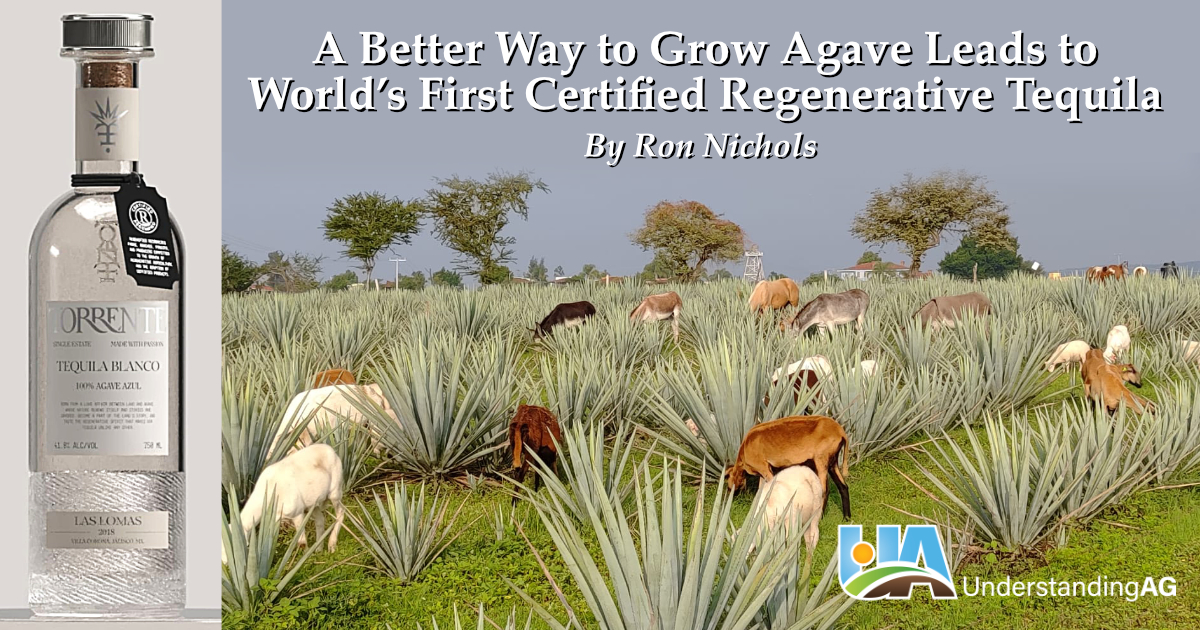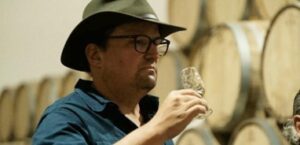
Life is short so embrace change.” That’s the “distilled” philosophy Rodrigo Mestas brings to his tequila business, his regenerative agriculture management style and his outlook on life.
In the acres he’s transitioned to regenerative agriculture, Mestas allows naturally occurring cover crops to emerge between the rows of the agave, and then grazes livestock- including cattle, horses, donkeys and sheep- to further advance soil health. (Photo courtesy Rodrigo Mestas)
In an industry where 99 percent of agave growers use chemical-intensive conventional agricultural practices (including himself, originally), Mestas always believed there was a better way to farm.
“Conventional agave production involves a lot of chemical applications to kill pests, disease and weeds,” he says. “Those inputs are costing more and more, and I realized I needed to do something different.”
Inspired by the soil health documentary film “Kiss the Ground,” Mestas began his personal regenerative journey in a familiar way, first viewing YouTube videos featuring soil health pioneers Gabe Brown, Ray Archuletta and Alejandro Carrillo among others, then attending a Soil Health Academy school to meet and learn from others in the regenerative ag space.
“At the Alabama SHA four years ago, I began talking with Allen Williams, Gabe and others, sharing photos of my operation and inviting them to visit my farm,” Mestas says. “Gabe suggested I start implementing the six principles of soil health on just a small percentage of my operation so I could compare what was happening in that regenerative area to my conventional fields.”
Upon returning from the SHA school, Mestas began his conventional-to-regenerative transition with a single agave field of about 12 acres, adding additional acreage incrementally, in the intervening years. Today, about 250 acres of his 2,200-acre Guadalajara, Mexico farm is fully regenerative.
“In the next 5-7 years, we plan to transition the remaining conventionally farmed acres to regenerative,” he says.
The world’s first Regenified™ tequila
Recognizing a potential marketing opportunity to become the first regenerative-certified tequila in the world, Mestas contacted Regenified™, a regenerative product certification company.
Tequlia Torrente™ has become the world’s first certified regeneratively grown tequila. (Photo courtesy Rodrigo)
Because Mestas is still early in his regenerative journey, he expected only a tier one or entry-level certification, but Mestas was pleased to learn that Regenified’s soil health, function and other tests revealed his regenerative acreage had achieved tier three certification (with tier five being the highest). Mestas says the Regenified™ certification process included following the product through fermentation, distillation and finishing.
At the end of that process, Tequila Torrente™, the world’s first regeneratively produced tequila, was born, and bottled in recycled glass. International trade challenges notwithstanding, Mestas says he is working with Regenified™ to place his product in California retail outlets and become the first regenerative-certified tequila in the U.S. market.
Sharing knowledge with colleagues and countrymen
In addition to implementing the six soil health principles in his own operation, Mestas is creating a regenerative learning and demonstration center on a 12-acre plot near his agave fields, to help teach agave growers and other regenerative farmers in his community and throughout Mexico, soil health-improving regenerative farming principles and practices.
Rodrigo Mestas is pictured here during the agave harvest at his farm in Guadalajara, Mexico.
Mestas sponsored the first soil health workshop this past year, which allowed local farmers the opportunity to attend the event free of charge. The workshop also provided additional education for his team. He says the center will charge attendees for future workshops, but all proceeds will be reinvested in the learning center to facilitate educational events in the years ahead.
Mentored by regenerative farming and ranching pioneer Alejando Carrillo, Mestas hopes he, too, can positively influence his farming colleagues by offering learning and training opportunities. At Mestas’ invitation, Carrillo and Soil Health Academy co-founder Ray Archuleta also conducted a specialty workshop this past year for agave farmers in Villa Cornona, Jalisco Mexico.
“Alejandro has been a crucial part of our project’s success and has had an enormous influence in my regenerative journey,” Mestas says. “Through our learning center, I hope to help others, like Alejandro has helped me.”
Mestas acknowledges that teaching other agave farmers how to implement regenerative principles will likely result in more “regenerative tequila competition” but he’s unbothered by that inevitability. Mestas’ commitment to leaving the world a better place for his children, is his priority.
“It’s a win-win for everyone,” he says. “I will fight my competition in the marketplace, but not on the land.”
Slow, steady and calm
Mestas says making the regenerative transition incrementally, over time, has allowed him to learn, adapt, plan and innovate without being overwhelmed. Implementing regenerative agricultural principles and practices, including grazing animals, requires constant observation, adaptation and most of all, calm.
Mestas fabricated a specially designed roller crimper to manage his naturally occurring cover crops between the rows of agave plants. (Photo courtesy Rodrigo Mestas.
“Each field is different, every day is different, so you have to observe and adapt,” he says. “You have to be calm because you can’t make good decisions when you’re scared.”
Mestas is especially focused on observing the behavior of his grazing livestock, including cattle, horses, donkeys and sheep, as well as the impact those grazing animals are having on the land. Determining whether an animal’s poor performance or bad grazing behavior is a result of epigenetics or a nutritional deficit is challenging, Mestas says, but it’s also part of what he enjoys about adaptive grazing management.
Mestas has seen a proliferation of life—insects, birds, predator species—in his regenerative acreage over the past four years. (Photo courtesy Rodrigo Mestas.
In many other regenerative operations, diverse cover crop mixes for soil health and grazing are selected and planted, but Mestas prefers to let nature do the cover crop selection for him, via the presence of the latent seed bed in his agave fields. “Why buy something nature gives you for free?” he says. “Plus, the plant species that emerge are adapted to this climate.”
Just four years into his regenerative transition, Mestas has seen his soil organic levels and infiltration rates double, and he has witnessed a precipitous increase in insect, bird and predator species and populations. In one recent instance, a pest infestation conventionally addressed with pesticides, was completely eliminated by ladybugs that were present in his regenerative agave fields.
“In conventional agriculture, solutions are sold to you by the big agrochemical companies,” he says. “In regenerative agriculture, solutions come from thinking and by working with nature.”
An unconventional and experimental mindset
Mestas says he believes not having had a conventional agricultural education has been an advantage in his regenerative journey. “I see things through a different set of eyes, and I haven’t had to unlearn a conventional mindset,” he says.
He also admits that having an aversion to the status quo can inspire innovation and advancement. “In life and in business, I don’t like static,” he says. “It’s just who I am.”
A marketing professional by training, Mestas is a scientist at heart, studying, observing and experimenting—continually—with every aspect of his business. From varying the density of agave plants in his fields, to planting agave plants in forests, to using different types of wood in the barrel-finishing tequila-making process, Mestas is always trying and testing new approaches and techniques.
“The only way to know if something will work is to find out,” he says. “Some people think I’m crazy, but my people trust me and we’re seeing the positive difference our regenerative management is having on the land, and that’s very rewarding.”
Mestas believes that the regenerative farming practices used to grow Tequila Torrente’s™ agave plants will result in “a truly unique and earth-friendly drink.”
Because it takes 6-7 years for an agave plant to mature for harvest, Mestas says it’s probably too early to know if his regenerative farming techniques will redound to a more flavorful or unique tequila product. But he’s optimistic that, in time, it will.
“I’m certain the presence of more micro and macro nutrients in the soil and in the agave plants will positively impact the flavor of our tequila,” he says. “In the future we also plan to source regeneratively produced aging barrels that will most certainly add other dimensions to make Tequila Torrente™ a truly unique and earth-friendly drink.”
Follow…
Instagram: Torrente Tequila
X: Tequila Torrente
Facebook: Tequila Torrente






